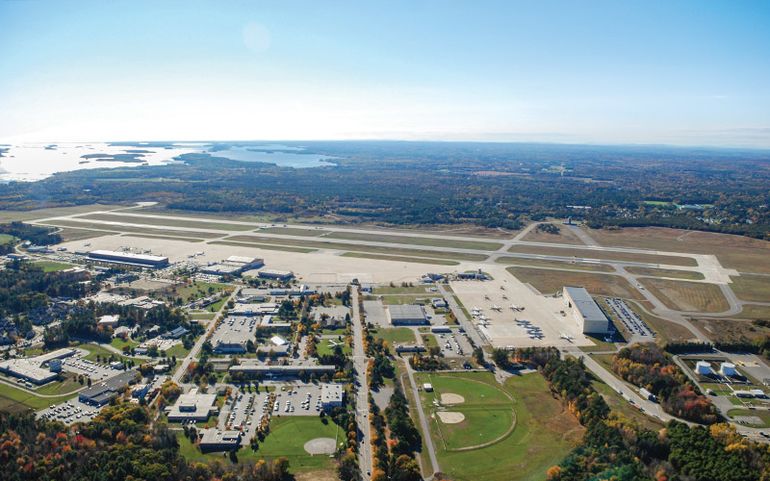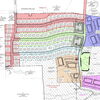Processing Your Payment
Please do not leave this page until complete. This can take a few moments.
Under Steve Levesque, Brunswick Landing delivers on a promise of creating new jobs
When Brunswick Landing first emerged out of the former Brunswick Naval Air Station in 2011, the projection was that it would create 800 to 900 jobs by 2018.
At last count, the 3,200-acre technology and business campus has created 1,620 and counting from 108 different business entities.
The evolution of the campus from Navy air base to a humming business community represents $350 million in private investment, says Steve Levesque, executive director of the Midcoast Regional Redevelopment Authority, which oversees the complex.
There are nine real estate development firms doing work on the former base.
“A lot of renters have acquired their property,” he adds. “Several leases have turned into purchase options.”
No one could have predicted it when the base closed in 2011, with the country still climbing out of recession and the Brunswick area reeling from the loss of thousands of Navy personnel and employees.
Levesque says much of that transformation comes from the focus on innovation.
“There was a very good reuse plan,” he says as he sits in his office on the second floor of the terminal at the Brunswick Executive Airport. “It made a lot of sense and created something that's not your average industrial park.”
He also cites community input and support, the focus on sustainability, the location and the “amazing team” that makes up the MRRA staff.
A commitment deeper than a job description
As he drives around the complex, pointing out businesses, what they do, how they came to be there, who owns them and what their future may be, it's obvious that his commitment to Brunswick Landing is deeper than the job description.
The Association of Defense Communities, which serves as a knowledge base for active defense communities and those that have closed and are being redeveloped, presented Levesque with its Leadership Award in 2015.
Tim Ford, CEO of the organization, told Mainebiz last year that comparing development projects isn't easy — each one is has its own characteristics.
“That said, since the announcement was made to close Brunswick NAS, it has been one of the most successful reuse efforts in terms of the speed of redevelopment and its overall success,” he told Mainebiz.
Aside from the region, state and congressional delegation support of the project, MRRA has a “great team on the ground.”
“Brunswick has made it work,” he said.
Brunswick Landing's success has had a ripple effect on the local economy.
“We've certainly been a catalyst,” Levesque says.
Cook's Corner shopping area, which is next to the site on Route 24, has struggled with vacancies since the base closed, but is reemerging. So is nearby Topsham, which benefits from activity at the Brunswick site as well as its 74-acre Topsham annex.
The housing on the former base, single-family homes and duplex workforce housing, is 100% occupied. Some 230 units have been sold.
“People have come back,” Levesque said. “The housing filled up much quicker than we anticipated.”
'Scared to death'
The town, region and state felt a collective shudder when the Navy announced in 2005 that the base would close in 2011.
The numbers were staggering — it would mean the loss of 6,500 jobs, 700 of them civilian, and a $140 million payroll that had been vital to the local economy since 1943.
The vacancy rate in Brunswick and the surrounding area was expected to hit 10%, with a loss of $14 million in rent and mortgage income. Area schools were expected to lose 10% of their students and millions in federal school aid that went with them.
“It's different from a mill closure,” Levesque says. “As terrible as it is when a mill closes, people tend to stay in the community and find other jobs.”
The 700 civilian employees of the base probably did that, he says. “But there were 4,000 active military, and they moved, with their families,” he says.
The hit was tremendous.
“They had huge spending power, they were in the schools, they had spouses who worked in the community,” he says.
Plans for redevelopment began shortly after the closure announcement was made.
“Obviously, we were scared to death,” he says.
The plan was to put together a project that would eventually equal the economic impact the Navy had.
The planning process made an effort to get the community on board. He says the state and congressional delegation have been supportive from the beginning.
“Businesses embraced it, the public embraced it,” he says. “People wanted to be a part of it.”
Visioning sessions were held for the general public, for civilian employees, and other groups to determine what they'd like to see in the transformation.
One was also held for high school students.
“We weren't sure of how it was going to go,” Levesque says, laughing. “We figured we'd probably see a lot of skateboard parks.”
The surprise was more than pleasant, it was an eye-opener. “These kids were all about the future, all about technology and innovation,” he says. “What we've done with technology? It comes from them.”
The new name — Brunswick Landing: Maine's Center for Innovation — came from the high schoolers. “They grasped the future and how this ties in,” he says.
Still some challenges
Once the Navy made the decision to close the base, it stopped maintaining buildings and infrastructure.
That's one of the major issues the MRRA has to deal with as it continues to recruit businesses.
The vacant buildings aren't energy efficient, their infrastructure no longer functions. Many don't meet Americans with Disabilities Act standards.
There are very large hangar spaces to fill — including those built by the Navy in 2005 to house Boeing 737s.
“I spend a lot of time out of state [recruiting],” Levesque says.
Maine businesses that want to relocate to Brunswick Landing have to prove they can't find an adequate site in their home community. The campus is supposed to help build economy, not shift it from one part of the state to another.
The most recent business to land there, Richmond's Kennebec River Biosciences, is an example.
The aquaculture company needed specialized laboratory and manufacturing space.
Owners found it in the former 9,500-square-foot Navy mess hall, which has coolers, freezers, large kitchen space and a loading dock. It has been vacant since 2011. MRRA is refurbishing the building.
Keeping promises
Under MRRA's watch, the former Navy hotel and nearby barracks, both built in 2004, have been converted to senior housing and workforce townhouses, respectively.
Plans at Brunswick Landing call for a wooded office park in the area that borders busy Route 24 and upgrades to the trail system that winds through the woods around the campus. Some 1,000 acres will remain open space.
Technology and innovation are the focus, with TechPlace, an incubator that houses 35 startups and small businesses, and the Maine Technology Institute, which helps fund businesses.
There are campuses of the University of Maine Augusta and Southern Maine Community College. Aviation-related businesses use much of the former airport area.
The Wayfair call center and SaviLinx contact center both employ hundreds.
But there are also businesses like Avita Memory Care, Black Diamond Whiskey distillery, Blue Dog Daycare and the FlightDeck Brewery and tasting room.
The goal of achieving energy sustainability is at about 75%, with the addition of a 1.5 megawatt solar farm, which began operating in December. An anaerobic biogas generator also provides energy on site, and the MRRA is looking to add solar or wind energy.
Levesque believes the site will equal the Navy's contribution to the local economy 10 to 12 years after closure.
When there was last an active Navy presence at the base, 2008 and 2009, the payroll was about $130 million a year, Levesque says. The payroll at Brunswick landing is close to $100 million a year, with the average pay $50,000 a year.
The goal is to get as much tax revenue from Brunswick Landing and the Topsham annex as possible.
Nearly $160 million in valuation has been added to the tax rolls in Brunswick and Topsham, and nearly $3 million is being paid annually in real estate taxes, according to the MRRA 2017 annual report.
“The taxpayers paid for this place, and if there's a financial windfall, it should go back to them,” Levesque says.
When Levesque first took the job of executive director in 2008, after the MRRA was formed by the Legislature, he thought he'd end up “embroiled in a lot more political strife.”
The level of cooperation that's paved the way for what's happened over the past six-plus years has surprised him.
“There was a lot of pre-planning, transparency, a lot of time educating the public,” he says.
It was all about building partnerships. “It works better if everyone can take credit.”
Out of that grew promises to the community about what would happen.
“Then we delivered, and delivering on the promise was pretty important, but it was all about that collaboration.”
Read more
At Auburn Manufacturing, Kathie Leonard stokes a global market for heat-resistant materials
Joshua Broder leads fast-growing Tilson towards $77M in annual sales, hundreds of jobs
2018 Business Leaders of the Year
At Auburn Manufacturing, Kathie Leonard stokes a global market for heat-resistant materials
Joshua Broder leads fast-growing Tilson towards $77M in annual sales, hundreds of jobs
Meet the 2018 Mainebiz Business Leaders of the Year on May 3

















Comments